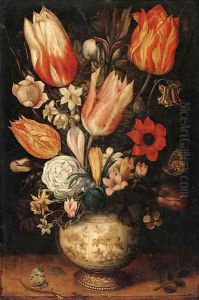Ambrosius Bosschaert I Paintings
Ambrosius Bosschaert the Elder was a prominent still life painter of the Dutch Golden Age, renowned for his detailed and vibrant representations of flowers. Born in Antwerp in 1573, Bosschaert was part of a family of painters; he was the head of a dynasty that continued influencing the development of still life painting in Europe through his sons and other relatives well into the 17th century.
Ambrosius became a member of the Antwerp Guild of Saint Luke in 1593, but due to religious persecution as a Protestant, he moved to Middelburg in the Dutch Republic around 1587, where he spent most of his career. Middelburg was a center for the cultivation of exotic flowers, and this proximity to a variety of species allowed Bosschaert to study them in detail and render them with scientific accuracy in his compositions.
His works are characterized by their meticulous execution, harmonious composition, and vibrant colors. He often painted on copper or wood panels, which allowed for fine detailing and helped preserve the brilliance of his colors. Bosschaert's paintings typically feature an assemblage of flowers, arranged in ornate vases or wreaths, against a neutral background to minimize distraction and emphasize the beauty of the subject matter.
Throughout his career, Bosschaert never deviated significantly from this subject matter, which was highly popular among the affluent Dutch middle classes of the time. These paintings were not only appreciated for their aesthetic qualities but also had symbolic meanings. Flowers in his paintings, such as tulips, roses, and lilies, often had emblematic significances relating to the transience of life and the concept of vanitas.
Ambrosius Bosschaert the Elder passed away in The Hague in 1621, leaving behind a legacy that was carried on through his sons Ambrosius Bosschaert the Younger, Johannes Bosschaert, and Abraham Bosschaert, all of whom became accomplished still life painters. His influence extended to other artists of the time, such as Balthasar van der Ast, who married Bosschaert's daughter and also specialized in still life paintings. Bosschaert's work continues to be celebrated for its contribution to the development of the still life genre in European art.
